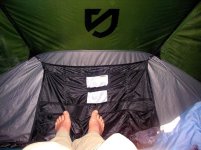- Joined
- Apr 30, 2024
- Messages
- 3
- Reaction score
- 6
Hi,
I live in Newfoundland Canada and do canoe camping trips here. I have done quite a few trips and I currently use this tent. https://www.atmosphere.ca/en/pdp/ma...1jHWg_gEA2EGIggAVohoCzfkQAvD_BwE&gclsrc=aw.ds
I got it a few years ago on sale and it has served me well. Easy to set up, keeps the rain out and such. The issue I am having is that I do solo canoe trips and the tent footprint makes it hard for me to find a decent spot to set up my camp. It's not bad but I am looking for something smaller that will make it easier to find a camping spot. Some kind of one person tent I think. The places I go are rocky, covered in alders, trees, marshland and usually unhospitable. I need something that can reduce my footprint and make it a little easier to find a suitable spot. I am looking to cover some new ground and am concerned about finding places to set up. Also needs to be very rain proof, I can count on it raining while I'm out and need to stay dry.
Thanks,
Canoeflyfisher
I live in Newfoundland Canada and do canoe camping trips here. I have done quite a few trips and I currently use this tent. https://www.atmosphere.ca/en/pdp/ma...1jHWg_gEA2EGIggAVohoCzfkQAvD_BwE&gclsrc=aw.ds
I got it a few years ago on sale and it has served me well. Easy to set up, keeps the rain out and such. The issue I am having is that I do solo canoe trips and the tent footprint makes it hard for me to find a decent spot to set up my camp. It's not bad but I am looking for something smaller that will make it easier to find a camping spot. Some kind of one person tent I think. The places I go are rocky, covered in alders, trees, marshland and usually unhospitable. I need something that can reduce my footprint and make it a little easier to find a suitable spot. I am looking to cover some new ground and am concerned about finding places to set up. Also needs to be very rain proof, I can count on it raining while I'm out and need to stay dry.
Thanks,
Canoeflyfisher



